Hikoki CR 13VEY Handleiding
Hikoki
Niet gecategoriseerd
CR 13VEY
Bekijk gratis de handleiding van Hikoki CR 13VEY (152 pagina’s), behorend tot de categorie Niet gecategoriseerd. Deze gids werd als nuttig beoordeeld door 45 mensen en kreeg gemiddeld 4.7 sterren uit 23 reviews. Heb je een vraag over Hikoki CR 13VEY of wil je andere gebruikers van dit product iets vragen? Stel een vraag
Pagina 1/152

Handling instructions
Bedienungsanleitung
Mode d’emploi
Istruzioni per l’uso
Gebruiksaanwijzing
Instrucciones de manejo
Instruções de uso
Bruksanvisning
Brugsanvisning
Bruksanvisning
Käyttöohjeet
Οδηγίες χειρισμού
Instrukcja obsługi
Kezelési utasítás
Návod k obsluze
Kullanım talimatları
Instrucţiuni de utilizare
Navodila za rokovanje
Pokyny na manipuláciu
Инструкция за експлоатация
Uputstvo za rukovanje
Upute za rukovanje
CR 13VEY
en
de
fr
it
nl
es
pt
sv
da
no
fi
hu
cs
tr
ro
sl
sk
bg
sr
hr
pl
el
en
de
fr
it
nl
es
pt
sv
da
no
fi
el
pl
hu
cs
tr
ro
sl
sk
bg
sr
hr

2
English
c) Prevent unintentional starting. Ensure the
switch is in the off -position before connecting
to power source and/or battery pack, picking up
or carrying the tool.
Carrying power tools with your fi nger on the switch
or energising power tools that have the switch on
invites accidents.
d) Remove any adjusting key or wrench before
turning the power tool on.
A wrench or a key left attached to a rotating part of
the power tool may result in personal injury.
e) Do not overreach. Keep proper footing and
balance at all times.
This enables better control of the power tool in
unexpected situations.
f) Dress properly. Do not wear loose clothing or
jewellery. Keep your hair and clothing away
from moving parts.
Loose clothes, jewellery or long hair can be caught in
moving parts.
g) If devices are provided for the connection of
dust extraction and collection facilities, ensure
these are connected and properly used.
Use of dust collection can reduce dust-related
hazards.
h) Do not let familiarity gained from frequent use
of tools allow you to become complacent and
ignore tool safety principles.
A careless action can cause severe injury within a
fraction of a second.
4) Power tool use and care
a) Do not force the power tool. Use the correct
power tool for your application.
The correct power tool will do the job better and safer
at the rate for which it was designed.
b) Do not use the power tool if the switch does not
turn it on and off .
Any power tool that cannot be controlled with the
switch is dangerous and must be repaired.
c) Disconnect the plug from the power source and/
or remove the battery pack, if detachable, from
the power tool before making any adjustments,
changing accessories, or storing power tools.
Such preventive safety measures reduce the risk of
starting the power tool accidentally.
d) Store idle power tools out of the reach of
children and do not allow persons unfamiliar
with the power tool or these instructions to
operate the power tool.
Power tools are dangerous in the hands of untrained
users.
e) Maintain power tools and accessories. Check
for misalignment or binding of moving parts,
breakage of parts and any other condition
that may aff ect the power tool s operation. If ʼ
damaged, have the power tool repaired before
use.
Many accidents are caused by poorly maintained
power tools.
f) Keep cutting tools sharp and clean.
Properly maintained cutting tools with sharp cutting
edges are less likely to bind and are easier to control.
g) Use the power tool, accessories and tool bits
etc. in accordance with these instructions,
taking into account the working conditions and
the work to be performed.
Use of the power tool for operations diff erent from
those intended could result in a hazardous situation.
h) Keep handles and grasping surfaces dry, clean
and free from oil and grease.
Slippery handles and grasping surfaces do not
allow for safe handling and control of the tool in
unexpected situations.
GENERAL POWER TOOL SAFETY
WARNINGS
WARNING
Read all safety warnings, instructions, illustrations and
specifi cations provided with this power tool.
Failure to follow all instructions listed below may result in
electric shock, fi re and/or serious injury.
Save all warnings and instructions for future reference.
The term “power tool” in the warnings refers to your mains-
operated (corded) power tool or battery-operated (cordless)
power tool.
1) Work area safety
a) Keep work area clean and well lit.
Cluttered or dark areas invite accidents.
b) Do not operate power tools in explosive
atmospheres, such as in the presence of
fl ammable liquids, gases or dust.
Power tools create sparks which may ignite the dust
or fumes.
c) Keep children and bystanders away while
operating a power tool.
Distractions can cause you to lose control.
2) Electrical safety
a) Power tool plugs must match the outlet. Never
modify the plug in any way. Do not use any
adapter plugs with earthed (grounded) power
tools.
Unmodifi ed plugs and matching outlets will reduce
risk of electric shock.
b) Avoid body contact with earthed or grounded
surfaces, such as pipes, radiators, ranges and
refrigerators.
There is an increased risk of electric shock if your
body is earthed or grounded.
c) Do not expose power tools to rain or wet
conditions.
Water entering a power tool will increase the risk of
electric shock.
d) Do not abuse the cord. Never use the cord for
carrying, pulling or unplugging the power tool.
Keep cord away from heat, oil, sharp edges or
moving parts.
Damaged or entangled cords increase the risk of
electric shock.
e) When operating a power tool outdoors, use an
extension cord suitable for outdoor use.
Use of a cord suitable for outdoor use reduces the
risk of electric shock.
f) If operating a power tool in a damp location
is unavoidable, use a residual current device
(RCD) protected supply.
Use of an RCD reduces the risk of electric shock.
3) Personal safety
a) Stay alert, watch what you are doing and use
common sense when operating a power tool.
Do not use a power tool while you are tired
or under the infl uence of drugs, alcohol or
medication.
A moment of inattention while operating power tools
may result in serious personal injury.
b) Use personal protective equipment. Always
wear eye protection.
Protective equipment such as a dust mask, non-skid
safety shoes, hard hat or hearing protection used for
appropriate conditions will reduce personal injuries.
(Original instructions)

3
English
5) Service
a) Have your power tool serviced by a qualifi ed
repair person using only identical replacement
parts.
This will ensure that the safety of the power tool is
maintained.
PRECAUTION
Keep children and infi rm persons away.
When not in use, tools should be stored out of reach of
children and infi rm persons.
RECIPROCATING SAW SAFETY
WARNINGS
1. Hold the power tool by insulated gripping surfaces,
when performing an operation where the cutting
accessory may contact hidden wiring or its own
cord.
Cutting accessory contacting a "live" wire may make
exposed metal parts of the power tool "live" and could
give the operator an electric shock.
2. Use clamps or another practical way to secure and
support the workpiece to a stable platform.
Holding the workpiece by hand or against your body
leaves it unstable and may lead to loss of control.
ADDITIONAL SAFETY WARNINGS
1. Preparing and checking the work environment. Make
sure that the work site meets all the conditions laid forth
in the precautions.
2. Ensure that the power source to be utilized conforms
to the power requirements specifi ed on the product
nameplate.
3. Ensure that the power switch is in the OFF position.
If the plug is connected to a receptacle while the power
switch is in the ON position, the power tool will start
operating immediately, which could cause a serious
accident.
4. When the work area is removed from the power source,
use an extension cord of suffi cient thickness and rated
capacity. The extension cord should be kept as short as
practicable.
5. Prior to cutting into walls, ceilings or fl oors, ensure there
are no electric cables or conduits inside.
6. Dust produced in operation
The dust produced in normal operation may aff ect the
operator’s health. To wear a dust mask is recommended.
7. When using this unit continuously, the unit may overheat,
leading to damage in the motor and switch. Therefore,
whenever the housing becomes hot, give the saw a
break for a while.
8. If the machine is used continuously at minimum speed,
an extra load is applied to the motor which can result in
motor seizure. Always operate the power tool so that
the blade is not caught by the material during operation.
Always adjust the blade speed to enable smooth cutting.
9. Always hold the body handle and front cover of the
power tool fi rmly. Otherwise the counterforce produced
may result in inaccurate and even dangerous operation.
10. Mounting the blade ( )Fig. 5
This unit employs a detachable mechanism that enables
mounting and removal of saw blades without the use of a
wrench or other tools.
○ Turn off the switch and unplug the power cord.
Be absolutely sure to keep the switch turned off and the
power cord unplugged to prevent any accident.
○ Pull the back of the saw blade two or three times by hand
and check that the blade is securely mounted. When
pulling the blade, you will know it is properly mounted if it
clicks and the lever moves slightly.
○ When pulling the saw blade, be absolutely sure to pull it
from the back. Pulling other parts of the blade will result
in an injury.
11. Maintenance and inspection of saw blade mount
○ After use, blow away sawdust, earth, sand, moisture,
etc., with air or brush them away with a brush, etc., to
ensure that the blade mount can function smoothly.
○ As shown in , carry out lubrication around the Fig. 14
blade holder on a periodic basis by use of cutting fl uid,
etc.
○ Continued use of the tool without cleaning and lubricating
the area where the saw blade is installed can result in
some slack movement of the lever due to accumulated
sawdust and chips. Then, clean up the inside of the
blade holder with air and the like and carry out suffi cient
lubrication.
○ Do not use any saw blade with a worn-out blade hole
(A). Otherwise, the saw blade can come off , resulting in
personal injury. ( )Fig. 1
12. Adjusting the swing cutting operation
○ Even for soft materials, you should perform straight
cutting if you wish to make curved or clean cuts.
○ Dust and dirt accumulated on the change lever
section can degrade the function of the change lever.
Periodically clean the change lever section.
○ When performing swing cutting, use a saw with straight
blade. If a saw with curved blade is used, the saw blade
may be broken or the unit may be damaged.
13. How to use
○ Avoid carrying it plugged to the outlet with your fi nger on
the switch. A sudden startup can result in an unexpected
injury.
○ Be careful not to let sawdust, earth, moisture, etc., enter
the inside of the machine through the plunger section
during operation. If sawdust and the like accumulate in
the plunger section, always clean it before use.
○ Do not remove the front cover. Hold fi rmly the front cover
by hand to operate. But, do not extend your hand or
fi nger beyond the fl ange of front cover to avoid an injury.
○ During use, press the base against the material while
cutting.
Vibration can damage the saw blade if the base is not
pressed fi rmly against the workpiece.
Furthermore, a tip of the saw blade can sometimes
contact the inner wall of the pipe, damaging the saw blade.
○ Select a saw blade of the most appropriate length.
Ideally, the length protruding from the base of the saw
blade after subtracting the stroke quantity should be
larger than the material (see ).Fig. 10
If you cut a large pipe, large block of wood, etc., that
exceeds the cutting capacity of a blade; there is a risk
that the blade may contact with the inner wall of the pipe,
wood, etc., resulting in damage.
○ ffi To maximize cutting e ciency for the materials you are
using and working conditions, adjust the speed of the
saw blade and the switching to swing cutting.
Cutting
○ Press the base fi rmly against the workpiece.
○ Never apply any unreasonable force to the saw blade
when cutting. Doing so can easily break the blade.
○ Fasten a workpiece fi rmly before operation. (Fig. 11)
○ When cutting metallic materials, use proper machine
oil (turbine oil, etc.). When not using liquid machine oil,
apply grease over the workpiece.
The service life of the saw blade will be drastically
shortened if you don’t use machine oil.
○ Never apply any unreasonable force to the saw blade
when cutting. Also remember to press the base against
the lumber fi rmly.
Sawing curved lines
○ We recommend that you use the BI-METAL blade
mentioned in for the saw blade since it is tough Table 2
and hardly breaks.
Product specificaties
| Merk: | Hikoki |
| Categorie: | Niet gecategoriseerd |
| Model: | CR 13VEY |
Heb je hulp nodig?
Als je hulp nodig hebt met Hikoki CR 13VEY stel dan hieronder een vraag en andere gebruikers zullen je antwoorden
Handleiding Niet gecategoriseerd Hikoki
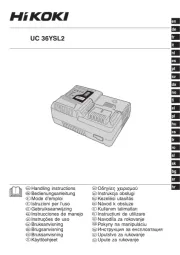
19 Maart 2025
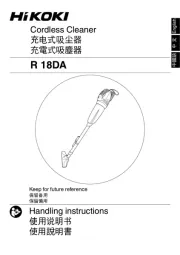
7 December 2024

25 November 2024

9 Juli 2024

3 Juli 2024
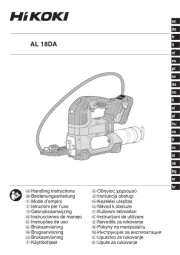
3 Juli 2024
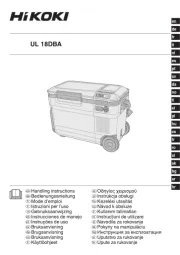
3 Juli 2024
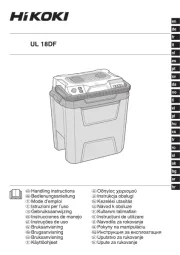
3 Juli 2024

28 December 2023

28 December 2023
Handleiding Niet gecategoriseerd
- Primus WindPower
- PUQpress
- Veise
- OBSBOT
- Favero
- Continental Edison
- Arduino
- Cyber Acoustics
- Moog
- Lvetek
- XP
- Hughes & Kettner
- WAYDOO
- Tach-It
- Polk
Nieuwste handleidingen voor Niet gecategoriseerd

13 September 2025

13 September 2025

13 September 2025

13 September 2025

13 September 2025

13 September 2025

13 September 2025

13 September 2025

13 September 2025
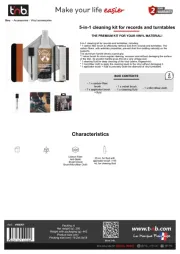
13 September 2025